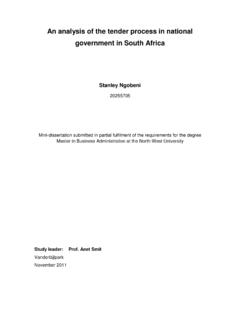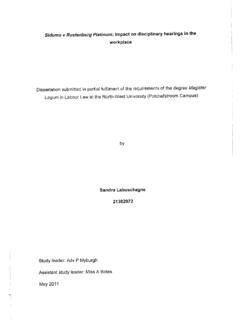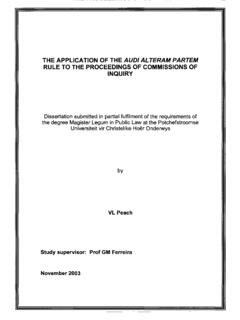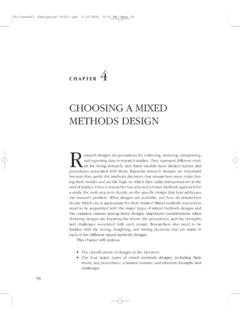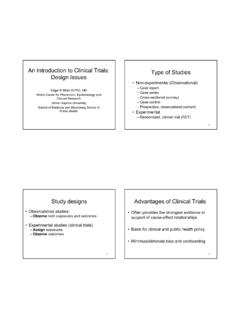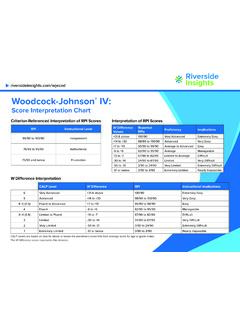Transcription of CHAPTER 6: DATA ANALYSIS AND INTERPRETATION 6.1. …
1 CHAPTER 6: DATA ANALYSIS AND INTERPRETATION 354 CHAPTER 6: DATA ANALYSIS AND INTERPRETATION INTRODUCTION CHAPTER Five described and explained in detail the process, rationale and purpose of the mixed methods research design , (cf. par. , p. 321, p. Fig. 16, p. 318; 17, p. 326; 18, p. 327). The mixed methods research design were applied in this research study to acquire an experiential overview of the extent of school sport management in a group of identified South African schools in accordance with their diverse needs. As was clearly outlined in CHAPTER Two, a combination of qualitative and quantitative research methodologies was employed for the purpose of more comprehensive responses to provide for unexpected developments and to clarify idiosyncratic circumstances. Furthermore, a theoretical framework based on an extensive literature study in Chapters Two, Three and Four assured the reliability (cf.)
2 Par. , p. 329; , p. 342) and validity (cf. par. , p. 328; , p. 346) of the measuring instruments. Grounded in the conceptualisation of the rather sophisticated research process that was made possible by the illustration of a mixed research model (cf. par. , p. 326; Fig. 18, p. 327), the description of the research design and methods in CHAPTER Five represented the rationale for decisions and procedures pertaining to data collection and the deconstruction process. In this CHAPTER , the captured data from the qualitative and quantitative research is presented, analysed, described and interpreted in a systematic manner as the next step of the research process. The documentation and ANALYSIS process aimed to present data in an intelligible and interpretable form in order to identify trends and relations in accordance with the research aims (cf. par.
3 , p. 12). In turn, the identified trends and relations in accordance with the research aims, would enable the researcher to develop a sport management programme for educator training in accordance with the diverse needs of South African schools. The research results were firstly presented as an ANALYSIS of the qualitative data obtained from the individual semi-structured interviews (cf. par. , p. 332). The ANALYSIS of the qualitative data was followed by an ANALYSIS of the quantitative data that was recorded by the questionnaire (cf. par. , p. 339). Furthermore, it is important to remain mindful of the fact that the data from the qualitative and quantitative sections are connected, in that the results of qualitative data contributed to the development of the quantitative questionnaire for school sport managers90 and related role players, concerning the relevant needs and competencies in accordance with the diverse needs of 90Cf.
4 P. par. , p. 316; , p. 324; , p. 333; , p. 339 CHAPTER 6: DATA ANALYSIS AND INTERPRETATION 355 schools (cf. Chap. 7). The comprehensive, connected data concludes with findings and recommendations (cf. Chap. 8). The focus now turns to the ANALYSIS and INTERPRETATION of the data for this study. ANALYSIS AND INTERPRETATION OF DATA Marshall and Rossman(1999:150) describe data ANALYSIS as the process of bringing order, structure and meaning to the mass of collected data. It is described as messy, ambiguous and time-consuming, but also as a creative and fascinating process. Broadly speaking - while it does not proceed in linear fashion -it is the activity of making sense of, interpreting and theorizing data that signifies a search for general statements among categories of data (Schwandt, 2007:6). There fore one could infer that data ANALYSIS requires some sort or form of logic applied to research.
5 In this regard, Best and Khan (2006:354) clearly posit that the ANALYSIS and INTERPRETATION of data represent the application of deductive and inductive logic to the research. Verma and Mallick (1999:29) and Morrison (2012:22,24) on the other hand, state that the interpretive approach (cf. par. , p. 307), which involves deduction from the data obtained, relies more on what it feels like to be a participant in the action under study, which is part of the qualitative research. Very often the researchers rely on their experience of particular settings to be able to read the information provided by the subjects involved in the study. While this thesis employed a mixed method of data collection, namely a combination of qualitative (cf. par. , p. 316; , p. 330) and quantitative methods (cf. par. , p. 316; , p. 339), it focused on the adoption of a pragmatic position and also used a phenomenological approach in conducting this research.
6 Antonius (2003:2) succinctly states that the word data points to information that is collected in a systematic way and organised and recorded to enable the reader to interpret the information correctly. As such, data are not collected haphazardly, but in response to some questions that the researcher wishes to answer. Schostak and Schostak (2008:10) capture the essences of capturing data well when they further add, that data are not given as a fixed, but are open to reconfiguration and thus alternative ways of seeing, finding answers to questions one wishes to answer. Implicated in the preceding views of Antonius (2003:2) and Schostak and Schostak (2008:10) are the two methods used to analyse data, namely qualitative and quantitative. Veal (2006:196); Schurink et al. (2011:397); Sesay (2011:95); Atkins and Wallace (2012:245) and Tuckman and Harper (2012:387) state that a qualitative study involves an inseparable relationship between data collection and data ANALYSIS in order to build a coherent INTERPRETATION of data.
7 An CHAPTER 6: DATA ANALYSIS AND INTERPRETATION 356 assumption of the qualitative researcher is that the human instrument is capable of ongoing fine-tuning in order to generate the most fertile array of data. Morgan and Krueger (1998:Vol. 6:3-17) on the other hand, provide important views when they reiterate that the ANALYSIS of qualitative methods must be systematic, sequential, verifiable and continuous. It requires time, is jeopardised by delay, is a process of comparison, is improved by feedback, seeks to enlighten and should entertain alternative explanations. As with qualitative methods for data ANALYSIS , the purpose of conducting a quantitative study, is to produce findings, but whereas qualitative methods use words (concepts, terms, symbols, etc.) to construct a framework for communicating the essence of what the data reveal, procedures and techniques are used to analyse data numerically, called quantitative methods (Sesay, 2011:74).
8 On the whole, regardless of the method (qualitative or quantitative), cf. par. , p. 13; , p. 16; , p. 17; , p. 318), the purpose of conducting a study, is to produce findings, and in order to do so, data should be analysed to transform data into findings. In this study, data will be analysed using both the qualitative and quantitative method. At this point in time, one has to take a closer look at both methods of ANALYSIS . Regarding qualitative and quantitative ANALYSIS of data, Kreuger and Neuman (2006:434) offer a useful outline of the differences and similarities between qualitative (cf. par. , p. 358) and quantitative methods (cf. par. , p. 367) of data ANALYSIS . According to these authors, qualitative and quantitative analyses are similar in four ways. Both forms of data ANALYSIS involve: Inference - the use of reasoning to reach a conclusion based on evidence; A public method or process - revealing their study design in some way; Comparison as a central process identification of patterns or aspects that are similar or different; and Striving to avoid errors, false conclusions and misleading inferences.
9 The core differences between qualitative (cf. par. , p. 358) and quantitative data (cf. par. , p. 367) ANALYSIS are as follows (Kreuger & Neuman, 2006:434-435): Qualitative data ANALYSIS is less standardised with the wide variety in approaches to qualitative research matched by the many approaches to data ANALYSIS , while quantitative researchers choose from a specialised, standard set of data ANALYSIS techniques; CHAPTER 6: DATA ANALYSIS AND INTERPRETATION 357 The results of qualitative data ANALYSIS guide subsequent data collection, and ANALYSIS is thus a less-distinct final stage of the research process than quantitative ANALYSIS , where data ANALYSIS does not begin until all data have been collected and condensed into numbers; Qualitative researchers create new concepts and theory by blending together empirical and abstract concepts, while quantitative researchers manipulate numbers in order to test a hypothesis with variable constructs.
10 And Qualitative data ANALYSIS is in the form of words, which are relatively imprecise, diffuse and context based, but quantitative researchers use the language of statistical relationships in ANALYSIS . Apart from Kreuger and Neuman, Robson (2011:408) also offers an equally important view on ANALYSIS and INTERPRETATION of data, when he posits that the process and products of ANALYSIS provide the bases for INTERPRETATION and ANALYSIS . It is therefore not an empty ritual, carried out for form s sake, between doing the study, and interpreting it, nor is it a bolt-on feature, which can be safely ignored until the data are collected. Robson (2011:468) further aptly points out that the central requirement in qualitative ANALYSIS is clear thinking on the part of the analyst. In closing, it can be said that the researcher should keep in mind the sequential list provided by Miles and Huberman (1994:9) of what they describe as a fairly classic set of analytic moves : Giving codes to the initial set of materials obtained from observation, interviews and documentary ANALYSIS ; Adding comments and reflections (commonly referred to as memos); Going through the materials trying to identify similar phrases, patterns, themes, relationships, sequences and differences between sub-groups; Taking identified patterns and themes out of the field to help focus the next wave of data collection; Gradually elaborating a small set of generalisations that cover the consistency one discerned in the data; and Linking the generalisations to a formalized body of knowledge in the form of constructs (theories.)
